Gender Discrimination in the Workplace: A Case Study on Morrison's
VerifiedAdded on 2022/11/25
|14
|3939
|72
Report
AI Summary
This report investigates the impact of gender discrimination on employee performance, using Morrison's as a case study. The report begins with an introduction outlining the importance of maintaining equality and diversity in the workplace and highlights the negative effects of discrimination on productivity and morale. It establishes the aims and objectives of the research, including examining the concept of gender discrimination, evaluating its impact, analyzing different types, and recommending mitigation strategies. The report then delves into the background and context, emphasizing the legal and ethical considerations associated with gender inequality. A comprehensive literature review explores the concept of gender discrimination, its effects on employee performance, and various forms such as sexism and sexual harassment. The research methodology outlines the interpretivism philosophy and inductive research approach. The report discusses the data collection methods, analysis techniques, ethical considerations, and measures to ensure validity and reliability. Finally, it addresses potential research limitations and includes a research plan for time management. The findings emphasize the importance of inclusivity, support for female employees in senior roles, and the development of gender-neutral policies to minimize discrimination and improve workplace performance.
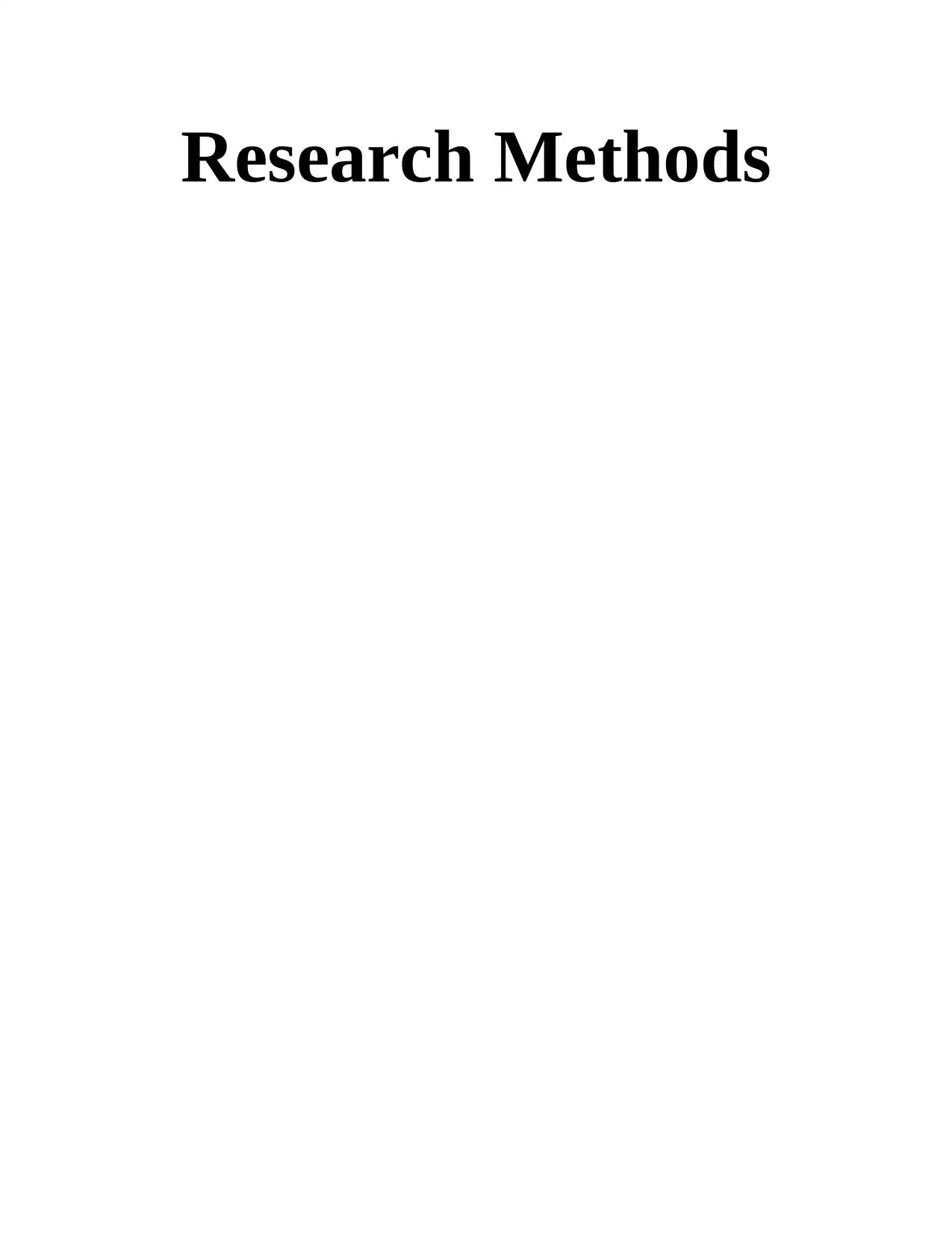
Research Methods
Paraphrase This Document
Need a fresh take? Get an instant paraphrase of this document with our AI Paraphraser
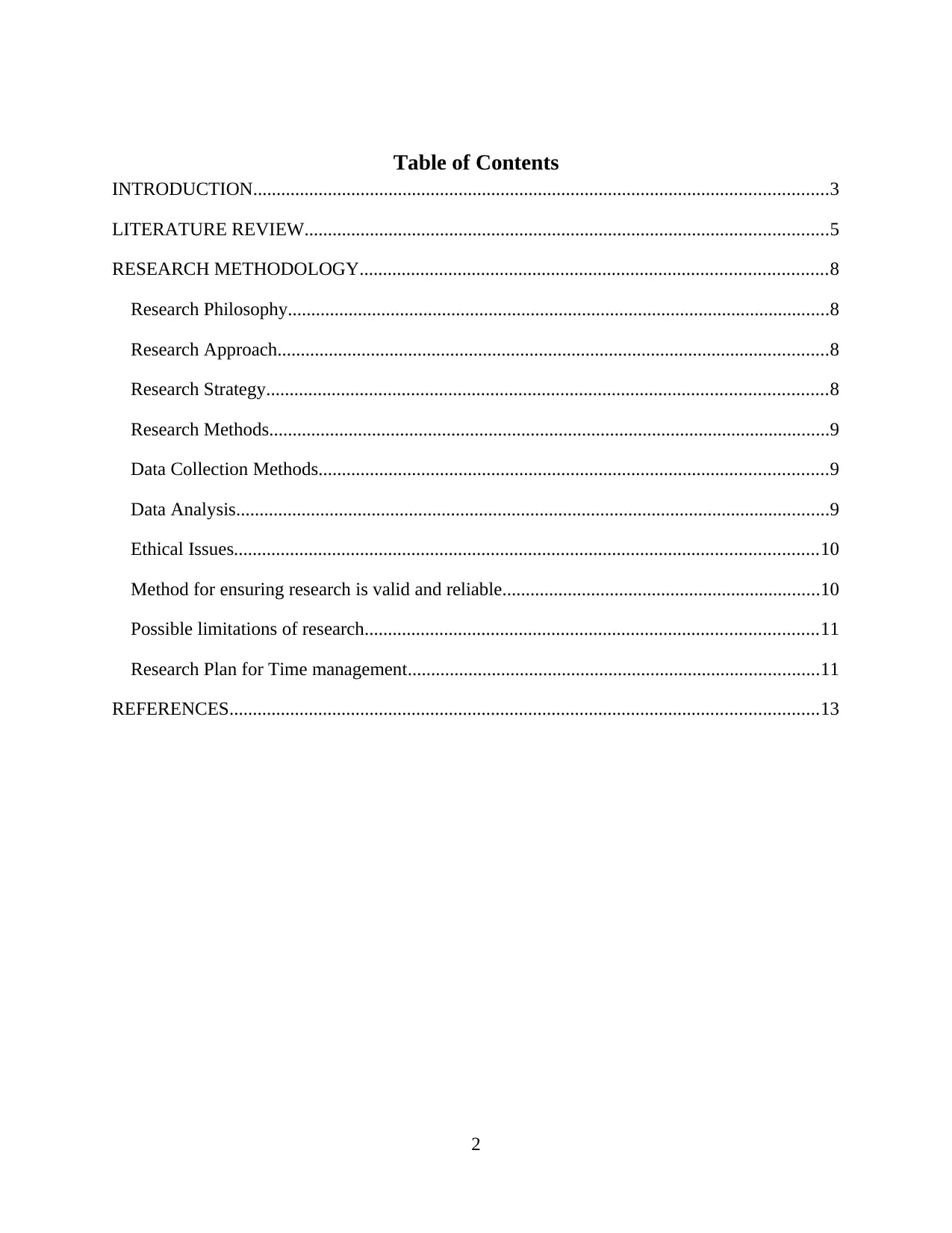
Table of Contents
INTRODUCTION...........................................................................................................................3
LITERATURE REVIEW................................................................................................................5
RESEARCH METHODOLOGY....................................................................................................8
Research Philosophy....................................................................................................................8
Research Approach......................................................................................................................8
Research Strategy........................................................................................................................8
Research Methods........................................................................................................................9
Data Collection Methods.............................................................................................................9
Data Analysis...............................................................................................................................9
Ethical Issues.............................................................................................................................10
Method for ensuring research is valid and reliable....................................................................10
Possible limitations of research.................................................................................................11
Research Plan for Time management........................................................................................11
REFERENCES..............................................................................................................................13
2
INTRODUCTION...........................................................................................................................3
LITERATURE REVIEW................................................................................................................5
RESEARCH METHODOLOGY....................................................................................................8
Research Philosophy....................................................................................................................8
Research Approach......................................................................................................................8
Research Strategy........................................................................................................................8
Research Methods........................................................................................................................9
Data Collection Methods.............................................................................................................9
Data Analysis...............................................................................................................................9
Ethical Issues.............................................................................................................................10
Method for ensuring research is valid and reliable....................................................................10
Possible limitations of research.................................................................................................11
Research Plan for Time management........................................................................................11
REFERENCES..............................................................................................................................13
2
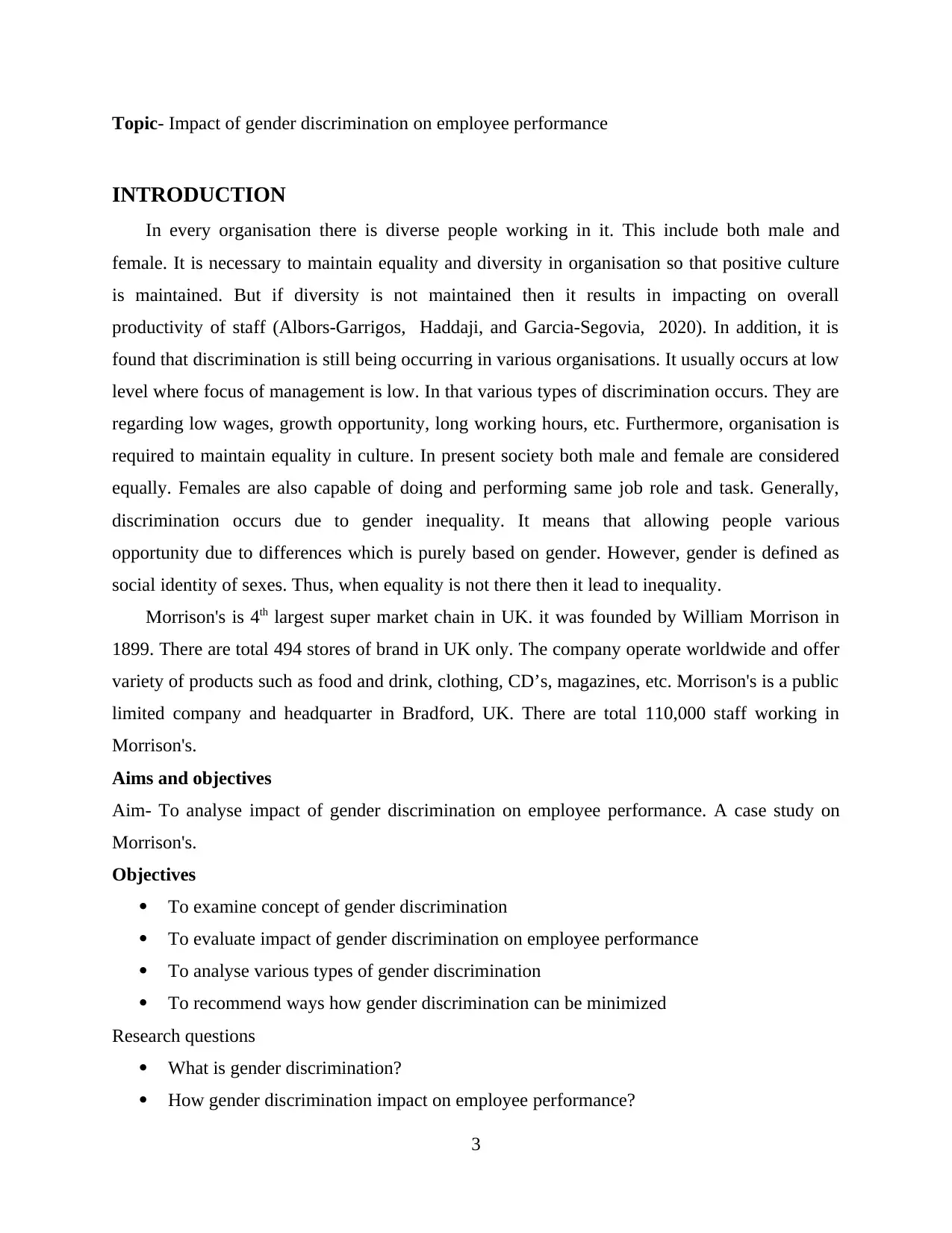
Topic- Impact of gender discrimination on employee performance
INTRODUCTION
In every organisation there is diverse people working in it. This include both male and
female. It is necessary to maintain equality and diversity in organisation so that positive culture
is maintained. But if diversity is not maintained then it results in impacting on overall
productivity of staff (Albors-Garrigos, Haddaji, and Garcia-Segovia, 2020). In addition, it is
found that discrimination is still being occurring in various organisations. It usually occurs at low
level where focus of management is low. In that various types of discrimination occurs. They are
regarding low wages, growth opportunity, long working hours, etc. Furthermore, organisation is
required to maintain equality in culture. In present society both male and female are considered
equally. Females are also capable of doing and performing same job role and task. Generally,
discrimination occurs due to gender inequality. It means that allowing people various
opportunity due to differences which is purely based on gender. However, gender is defined as
social identity of sexes. Thus, when equality is not there then it lead to inequality.
Morrison's is 4th largest super market chain in UK. it was founded by William Morrison in
1899. There are total 494 stores of brand in UK only. The company operate worldwide and offer
variety of products such as food and drink, clothing, CD’s, magazines, etc. Morrison's is a public
limited company and headquarter in Bradford, UK. There are total 110,000 staff working in
Morrison's.
Aims and objectives
Aim- To analyse impact of gender discrimination on employee performance. A case study on
Morrison's.
Objectives
To examine concept of gender discrimination
To evaluate impact of gender discrimination on employee performance
To analyse various types of gender discrimination
To recommend ways how gender discrimination can be minimized
Research questions
What is gender discrimination?
How gender discrimination impact on employee performance?
3
INTRODUCTION
In every organisation there is diverse people working in it. This include both male and
female. It is necessary to maintain equality and diversity in organisation so that positive culture
is maintained. But if diversity is not maintained then it results in impacting on overall
productivity of staff (Albors-Garrigos, Haddaji, and Garcia-Segovia, 2020). In addition, it is
found that discrimination is still being occurring in various organisations. It usually occurs at low
level where focus of management is low. In that various types of discrimination occurs. They are
regarding low wages, growth opportunity, long working hours, etc. Furthermore, organisation is
required to maintain equality in culture. In present society both male and female are considered
equally. Females are also capable of doing and performing same job role and task. Generally,
discrimination occurs due to gender inequality. It means that allowing people various
opportunity due to differences which is purely based on gender. However, gender is defined as
social identity of sexes. Thus, when equality is not there then it lead to inequality.
Morrison's is 4th largest super market chain in UK. it was founded by William Morrison in
1899. There are total 494 stores of brand in UK only. The company operate worldwide and offer
variety of products such as food and drink, clothing, CD’s, magazines, etc. Morrison's is a public
limited company and headquarter in Bradford, UK. There are total 110,000 staff working in
Morrison's.
Aims and objectives
Aim- To analyse impact of gender discrimination on employee performance. A case study on
Morrison's.
Objectives
To examine concept of gender discrimination
To evaluate impact of gender discrimination on employee performance
To analyse various types of gender discrimination
To recommend ways how gender discrimination can be minimized
Research questions
What is gender discrimination?
How gender discrimination impact on employee performance?
3
⊘ This is a preview!⊘
Do you want full access?
Subscribe today to unlock all pages.

Trusted by 1+ million students worldwide
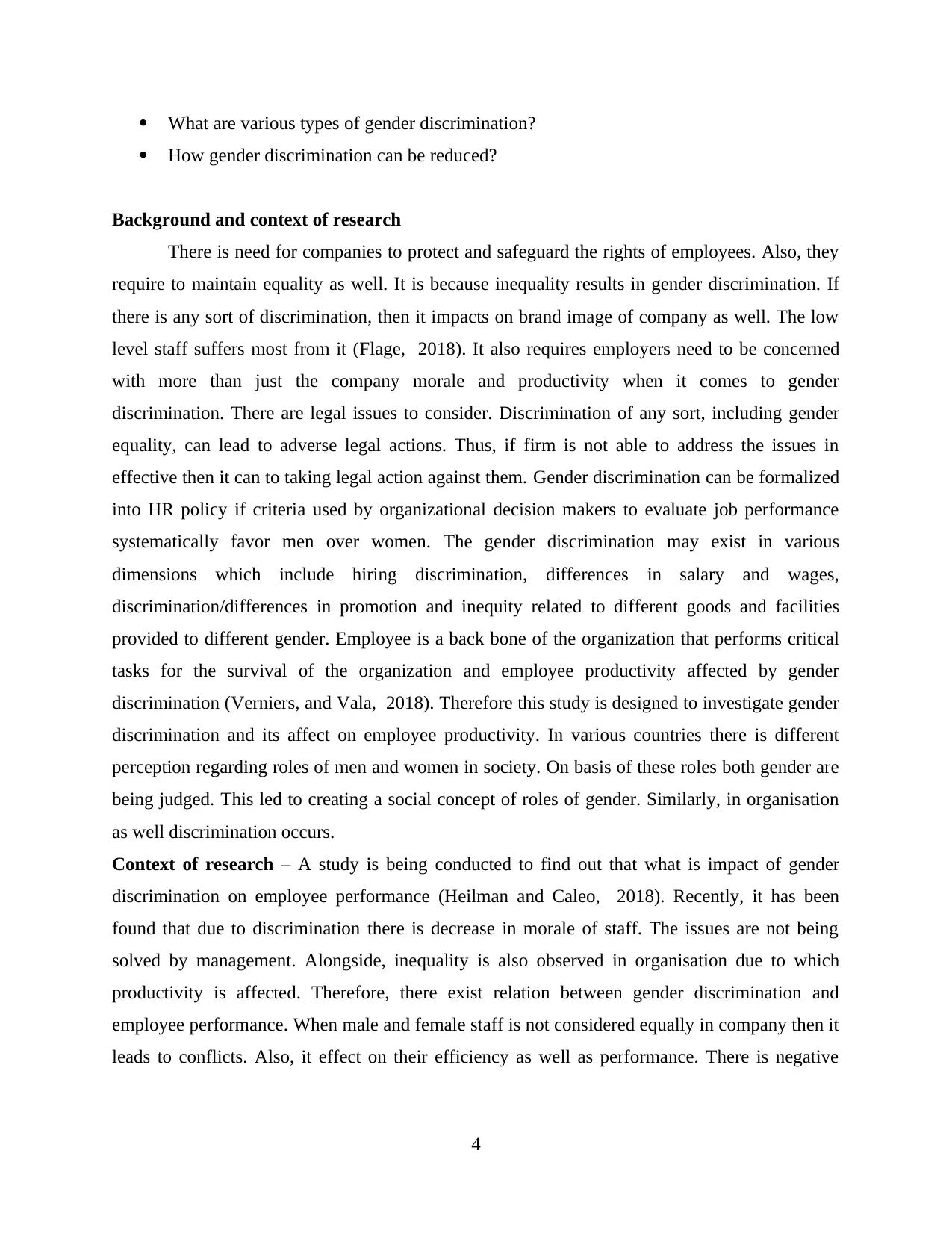
What are various types of gender discrimination?
How gender discrimination can be reduced?
Background and context of research
There is need for companies to protect and safeguard the rights of employees. Also, they
require to maintain equality as well. It is because inequality results in gender discrimination. If
there is any sort of discrimination, then it impacts on brand image of company as well. The low
level staff suffers most from it (Flage, 2018). It also requires employers need to be concerned
with more than just the company morale and productivity when it comes to gender
discrimination. There are legal issues to consider. Discrimination of any sort, including gender
equality, can lead to adverse legal actions. Thus, if firm is not able to address the issues in
effective then it can to taking legal action against them. Gender discrimination can be formalized
into HR policy if criteria used by organizational decision makers to evaluate job performance
systematically favor men over women. The gender discrimination may exist in various
dimensions which include hiring discrimination, differences in salary and wages,
discrimination/differences in promotion and inequity related to different goods and facilities
provided to different gender. Employee is a back bone of the organization that performs critical
tasks for the survival of the organization and employee productivity affected by gender
discrimination (Verniers, and Vala, 2018). Therefore this study is designed to investigate gender
discrimination and its affect on employee productivity. In various countries there is different
perception regarding roles of men and women in society. On basis of these roles both gender are
being judged. This led to creating a social concept of roles of gender. Similarly, in organisation
as well discrimination occurs.
Context of research – A study is being conducted to find out that what is impact of gender
discrimination on employee performance (Heilman and Caleo, 2018). Recently, it has been
found that due to discrimination there is decrease in morale of staff. The issues are not being
solved by management. Alongside, inequality is also observed in organisation due to which
productivity is affected. Therefore, there exist relation between gender discrimination and
employee performance. When male and female staff is not considered equally in company then it
leads to conflicts. Also, it effect on their efficiency as well as performance. There is negative
4
How gender discrimination can be reduced?
Background and context of research
There is need for companies to protect and safeguard the rights of employees. Also, they
require to maintain equality as well. It is because inequality results in gender discrimination. If
there is any sort of discrimination, then it impacts on brand image of company as well. The low
level staff suffers most from it (Flage, 2018). It also requires employers need to be concerned
with more than just the company morale and productivity when it comes to gender
discrimination. There are legal issues to consider. Discrimination of any sort, including gender
equality, can lead to adverse legal actions. Thus, if firm is not able to address the issues in
effective then it can to taking legal action against them. Gender discrimination can be formalized
into HR policy if criteria used by organizational decision makers to evaluate job performance
systematically favor men over women. The gender discrimination may exist in various
dimensions which include hiring discrimination, differences in salary and wages,
discrimination/differences in promotion and inequity related to different goods and facilities
provided to different gender. Employee is a back bone of the organization that performs critical
tasks for the survival of the organization and employee productivity affected by gender
discrimination (Verniers, and Vala, 2018). Therefore this study is designed to investigate gender
discrimination and its affect on employee productivity. In various countries there is different
perception regarding roles of men and women in society. On basis of these roles both gender are
being judged. This led to creating a social concept of roles of gender. Similarly, in organisation
as well discrimination occurs.
Context of research – A study is being conducted to find out that what is impact of gender
discrimination on employee performance (Heilman and Caleo, 2018). Recently, it has been
found that due to discrimination there is decrease in morale of staff. The issues are not being
solved by management. Alongside, inequality is also observed in organisation due to which
productivity is affected. Therefore, there exist relation between gender discrimination and
employee performance. When male and female staff is not considered equally in company then it
leads to conflicts. Also, it effect on their efficiency as well as performance. There is negative
4
Paraphrase This Document
Need a fresh take? Get an instant paraphrase of this document with our AI Paraphraser
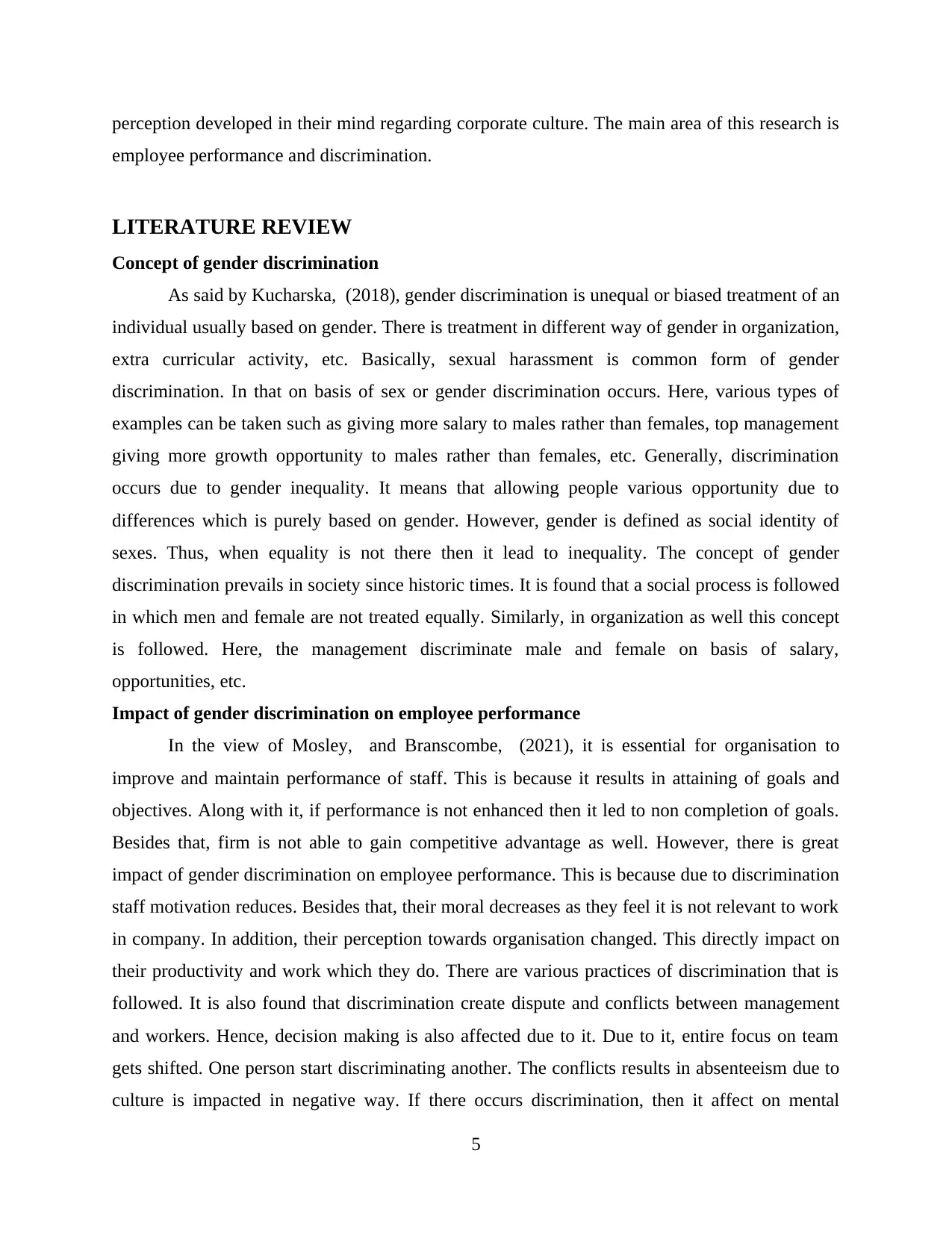
perception developed in their mind regarding corporate culture. The main area of this research is
employee performance and discrimination.
LITERATURE REVIEW
Concept of gender discrimination
As said by Kucharska, (2018), gender discrimination is unequal or biased treatment of an
individual usually based on gender. There is treatment in different way of gender in organization,
extra curricular activity, etc. Basically, sexual harassment is common form of gender
discrimination. In that on basis of sex or gender discrimination occurs. Here, various types of
examples can be taken such as giving more salary to males rather than females, top management
giving more growth opportunity to males rather than females, etc. Generally, discrimination
occurs due to gender inequality. It means that allowing people various opportunity due to
differences which is purely based on gender. However, gender is defined as social identity of
sexes. Thus, when equality is not there then it lead to inequality. The concept of gender
discrimination prevails in society since historic times. It is found that a social process is followed
in which men and female are not treated equally. Similarly, in organization as well this concept
is followed. Here, the management discriminate male and female on basis of salary,
opportunities, etc.
Impact of gender discrimination on employee performance
In the view of Mosley, and Branscombe, (2021), it is essential for organisation to
improve and maintain performance of staff. This is because it results in attaining of goals and
objectives. Along with it, if performance is not enhanced then it led to non completion of goals.
Besides that, firm is not able to gain competitive advantage as well. However, there is great
impact of gender discrimination on employee performance. This is because due to discrimination
staff motivation reduces. Besides that, their moral decreases as they feel it is not relevant to work
in company. In addition, their perception towards organisation changed. This directly impact on
their productivity and work which they do. There are various practices of discrimination that is
followed. It is also found that discrimination create dispute and conflicts between management
and workers. Hence, decision making is also affected due to it. Due to it, entire focus on team
gets shifted. One person start discriminating another. The conflicts results in absenteeism due to
culture is impacted in negative way. If there occurs discrimination, then it affect on mental
5
employee performance and discrimination.
LITERATURE REVIEW
Concept of gender discrimination
As said by Kucharska, (2018), gender discrimination is unequal or biased treatment of an
individual usually based on gender. There is treatment in different way of gender in organization,
extra curricular activity, etc. Basically, sexual harassment is common form of gender
discrimination. In that on basis of sex or gender discrimination occurs. Here, various types of
examples can be taken such as giving more salary to males rather than females, top management
giving more growth opportunity to males rather than females, etc. Generally, discrimination
occurs due to gender inequality. It means that allowing people various opportunity due to
differences which is purely based on gender. However, gender is defined as social identity of
sexes. Thus, when equality is not there then it lead to inequality. The concept of gender
discrimination prevails in society since historic times. It is found that a social process is followed
in which men and female are not treated equally. Similarly, in organization as well this concept
is followed. Here, the management discriminate male and female on basis of salary,
opportunities, etc.
Impact of gender discrimination on employee performance
In the view of Mosley, and Branscombe, (2021), it is essential for organisation to
improve and maintain performance of staff. This is because it results in attaining of goals and
objectives. Along with it, if performance is not enhanced then it led to non completion of goals.
Besides that, firm is not able to gain competitive advantage as well. However, there is great
impact of gender discrimination on employee performance. This is because due to discrimination
staff motivation reduces. Besides that, their moral decreases as they feel it is not relevant to work
in company. In addition, their perception towards organisation changed. This directly impact on
their productivity and work which they do. There are various practices of discrimination that is
followed. It is also found that discrimination create dispute and conflicts between management
and workers. Hence, decision making is also affected due to it. Due to it, entire focus on team
gets shifted. One person start discriminating another. The conflicts results in absenteeism due to
culture is impacted in negative way. If there occurs discrimination, then it affect on mental
5
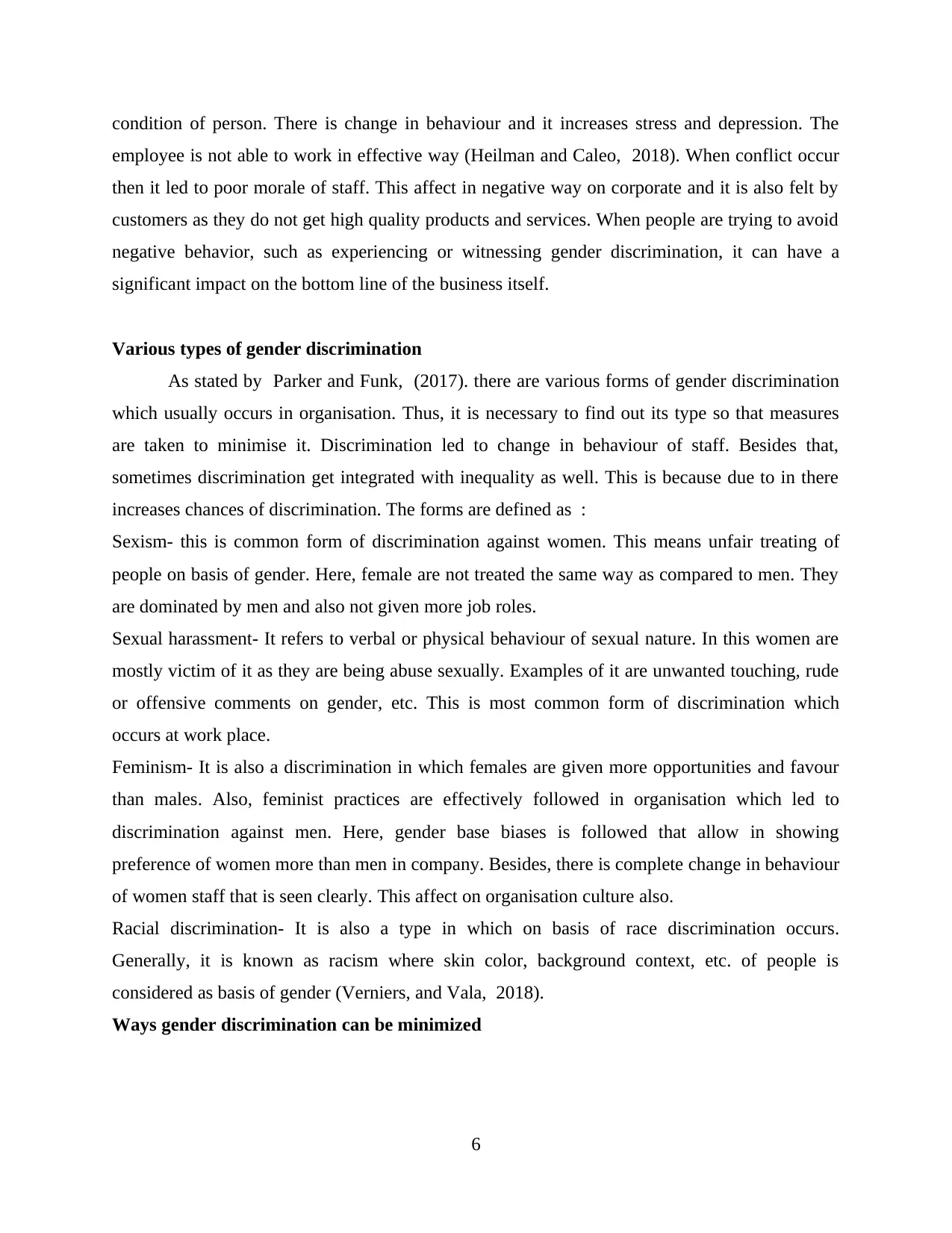
condition of person. There is change in behaviour and it increases stress and depression. The
employee is not able to work in effective way (Heilman and Caleo, 2018). When conflict occur
then it led to poor morale of staff. This affect in negative way on corporate and it is also felt by
customers as they do not get high quality products and services. When people are trying to avoid
negative behavior, such as experiencing or witnessing gender discrimination, it can have a
significant impact on the bottom line of the business itself.
Various types of gender discrimination
As stated by Parker and Funk, (2017). there are various forms of gender discrimination
which usually occurs in organisation. Thus, it is necessary to find out its type so that measures
are taken to minimise it. Discrimination led to change in behaviour of staff. Besides that,
sometimes discrimination get integrated with inequality as well. This is because due to in there
increases chances of discrimination. The forms are defined as :
Sexism- this is common form of discrimination against women. This means unfair treating of
people on basis of gender. Here, female are not treated the same way as compared to men. They
are dominated by men and also not given more job roles.
Sexual harassment- It refers to verbal or physical behaviour of sexual nature. In this women are
mostly victim of it as they are being abuse sexually. Examples of it are unwanted touching, rude
or offensive comments on gender, etc. This is most common form of discrimination which
occurs at work place.
Feminism- It is also a discrimination in which females are given more opportunities and favour
than males. Also, feminist practices are effectively followed in organisation which led to
discrimination against men. Here, gender base biases is followed that allow in showing
preference of women more than men in company. Besides, there is complete change in behaviour
of women staff that is seen clearly. This affect on organisation culture also.
Racial discrimination- It is also a type in which on basis of race discrimination occurs.
Generally, it is known as racism where skin color, background context, etc. of people is
considered as basis of gender (Verniers, and Vala, 2018).
Ways gender discrimination can be minimized
6
employee is not able to work in effective way (Heilman and Caleo, 2018). When conflict occur
then it led to poor morale of staff. This affect in negative way on corporate and it is also felt by
customers as they do not get high quality products and services. When people are trying to avoid
negative behavior, such as experiencing or witnessing gender discrimination, it can have a
significant impact on the bottom line of the business itself.
Various types of gender discrimination
As stated by Parker and Funk, (2017). there are various forms of gender discrimination
which usually occurs in organisation. Thus, it is necessary to find out its type so that measures
are taken to minimise it. Discrimination led to change in behaviour of staff. Besides that,
sometimes discrimination get integrated with inequality as well. This is because due to in there
increases chances of discrimination. The forms are defined as :
Sexism- this is common form of discrimination against women. This means unfair treating of
people on basis of gender. Here, female are not treated the same way as compared to men. They
are dominated by men and also not given more job roles.
Sexual harassment- It refers to verbal or physical behaviour of sexual nature. In this women are
mostly victim of it as they are being abuse sexually. Examples of it are unwanted touching, rude
or offensive comments on gender, etc. This is most common form of discrimination which
occurs at work place.
Feminism- It is also a discrimination in which females are given more opportunities and favour
than males. Also, feminist practices are effectively followed in organisation which led to
discrimination against men. Here, gender base biases is followed that allow in showing
preference of women more than men in company. Besides, there is complete change in behaviour
of women staff that is seen clearly. This affect on organisation culture also.
Racial discrimination- It is also a type in which on basis of race discrimination occurs.
Generally, it is known as racism where skin color, background context, etc. of people is
considered as basis of gender (Verniers, and Vala, 2018).
Ways gender discrimination can be minimized
6
⊘ This is a preview!⊘
Do you want full access?
Subscribe today to unlock all pages.

Trusted by 1+ million students worldwide
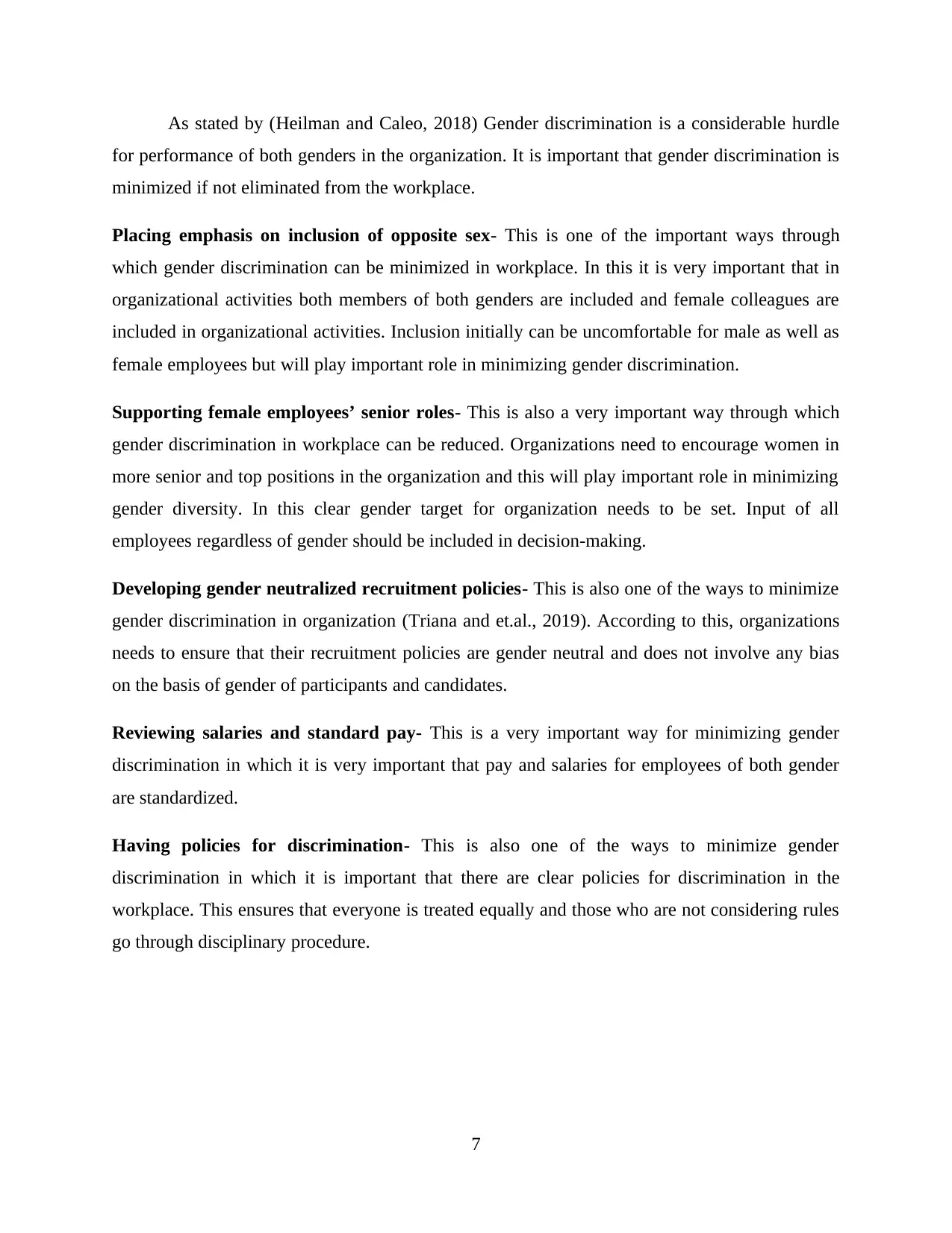
As stated by (Heilman and Caleo, 2018) Gender discrimination is a considerable hurdle
for performance of both genders in the organization. It is important that gender discrimination is
minimized if not eliminated from the workplace.
Placing emphasis on inclusion of opposite sex- This is one of the important ways through
which gender discrimination can be minimized in workplace. In this it is very important that in
organizational activities both members of both genders are included and female colleagues are
included in organizational activities. Inclusion initially can be uncomfortable for male as well as
female employees but will play important role in minimizing gender discrimination.
Supporting female employees’ senior roles- This is also a very important way through which
gender discrimination in workplace can be reduced. Organizations need to encourage women in
more senior and top positions in the organization and this will play important role in minimizing
gender diversity. In this clear gender target for organization needs to be set. Input of all
employees regardless of gender should be included in decision-making.
Developing gender neutralized recruitment policies- This is also one of the ways to minimize
gender discrimination in organization (Triana and et.al., 2019). According to this, organizations
needs to ensure that their recruitment policies are gender neutral and does not involve any bias
on the basis of gender of participants and candidates.
Reviewing salaries and standard pay- This is a very important way for minimizing gender
discrimination in which it is very important that pay and salaries for employees of both gender
are standardized.
Having policies for discrimination- This is also one of the ways to minimize gender
discrimination in which it is important that there are clear policies for discrimination in the
workplace. This ensures that everyone is treated equally and those who are not considering rules
go through disciplinary procedure.
7
for performance of both genders in the organization. It is important that gender discrimination is
minimized if not eliminated from the workplace.
Placing emphasis on inclusion of opposite sex- This is one of the important ways through
which gender discrimination can be minimized in workplace. In this it is very important that in
organizational activities both members of both genders are included and female colleagues are
included in organizational activities. Inclusion initially can be uncomfortable for male as well as
female employees but will play important role in minimizing gender discrimination.
Supporting female employees’ senior roles- This is also a very important way through which
gender discrimination in workplace can be reduced. Organizations need to encourage women in
more senior and top positions in the organization and this will play important role in minimizing
gender diversity. In this clear gender target for organization needs to be set. Input of all
employees regardless of gender should be included in decision-making.
Developing gender neutralized recruitment policies- This is also one of the ways to minimize
gender discrimination in organization (Triana and et.al., 2019). According to this, organizations
needs to ensure that their recruitment policies are gender neutral and does not involve any bias
on the basis of gender of participants and candidates.
Reviewing salaries and standard pay- This is a very important way for minimizing gender
discrimination in which it is very important that pay and salaries for employees of both gender
are standardized.
Having policies for discrimination- This is also one of the ways to minimize gender
discrimination in which it is important that there are clear policies for discrimination in the
workplace. This ensures that everyone is treated equally and those who are not considering rules
go through disciplinary procedure.
7
Paraphrase This Document
Need a fresh take? Get an instant paraphrase of this document with our AI Paraphraser
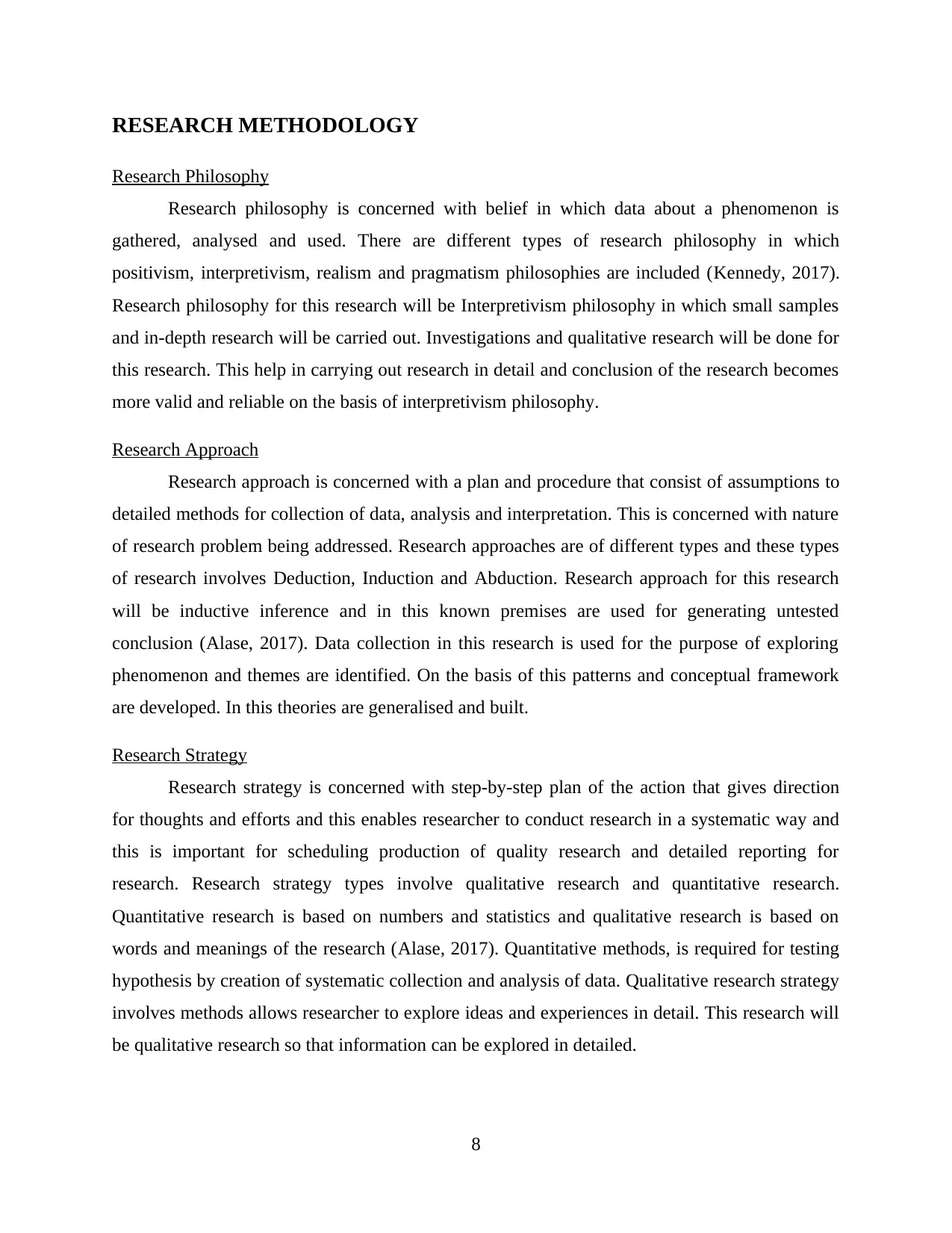
RESEARCH METHODOLOGY
Research Philosophy
Research philosophy is concerned with belief in which data about a phenomenon is
gathered, analysed and used. There are different types of research philosophy in which
positivism, interpretivism, realism and pragmatism philosophies are included (Kennedy, 2017).
Research philosophy for this research will be Interpretivism philosophy in which small samples
and in-depth research will be carried out. Investigations and qualitative research will be done for
this research. This help in carrying out research in detail and conclusion of the research becomes
more valid and reliable on the basis of interpretivism philosophy.
Research Approach
Research approach is concerned with a plan and procedure that consist of assumptions to
detailed methods for collection of data, analysis and interpretation. This is concerned with nature
of research problem being addressed. Research approaches are of different types and these types
of research involves Deduction, Induction and Abduction. Research approach for this research
will be inductive inference and in this known premises are used for generating untested
conclusion (Alase, 2017). Data collection in this research is used for the purpose of exploring
phenomenon and themes are identified. On the basis of this patterns and conceptual framework
are developed. In this theories are generalised and built.
Research Strategy
Research strategy is concerned with step-by-step plan of the action that gives direction
for thoughts and efforts and this enables researcher to conduct research in a systematic way and
this is important for scheduling production of quality research and detailed reporting for
research. Research strategy types involve qualitative research and quantitative research.
Quantitative research is based on numbers and statistics and qualitative research is based on
words and meanings of the research (Alase, 2017). Quantitative methods, is required for testing
hypothesis by creation of systematic collection and analysis of data. Qualitative research strategy
involves methods allows researcher to explore ideas and experiences in detail. This research will
be qualitative research so that information can be explored in detailed.
8
Research Philosophy
Research philosophy is concerned with belief in which data about a phenomenon is
gathered, analysed and used. There are different types of research philosophy in which
positivism, interpretivism, realism and pragmatism philosophies are included (Kennedy, 2017).
Research philosophy for this research will be Interpretivism philosophy in which small samples
and in-depth research will be carried out. Investigations and qualitative research will be done for
this research. This help in carrying out research in detail and conclusion of the research becomes
more valid and reliable on the basis of interpretivism philosophy.
Research Approach
Research approach is concerned with a plan and procedure that consist of assumptions to
detailed methods for collection of data, analysis and interpretation. This is concerned with nature
of research problem being addressed. Research approaches are of different types and these types
of research involves Deduction, Induction and Abduction. Research approach for this research
will be inductive inference and in this known premises are used for generating untested
conclusion (Alase, 2017). Data collection in this research is used for the purpose of exploring
phenomenon and themes are identified. On the basis of this patterns and conceptual framework
are developed. In this theories are generalised and built.
Research Strategy
Research strategy is concerned with step-by-step plan of the action that gives direction
for thoughts and efforts and this enables researcher to conduct research in a systematic way and
this is important for scheduling production of quality research and detailed reporting for
research. Research strategy types involve qualitative research and quantitative research.
Quantitative research is based on numbers and statistics and qualitative research is based on
words and meanings of the research (Alase, 2017). Quantitative methods, is required for testing
hypothesis by creation of systematic collection and analysis of data. Qualitative research strategy
involves methods allows researcher to explore ideas and experiences in detail. This research will
be qualitative research so that information can be explored in detailed.
8
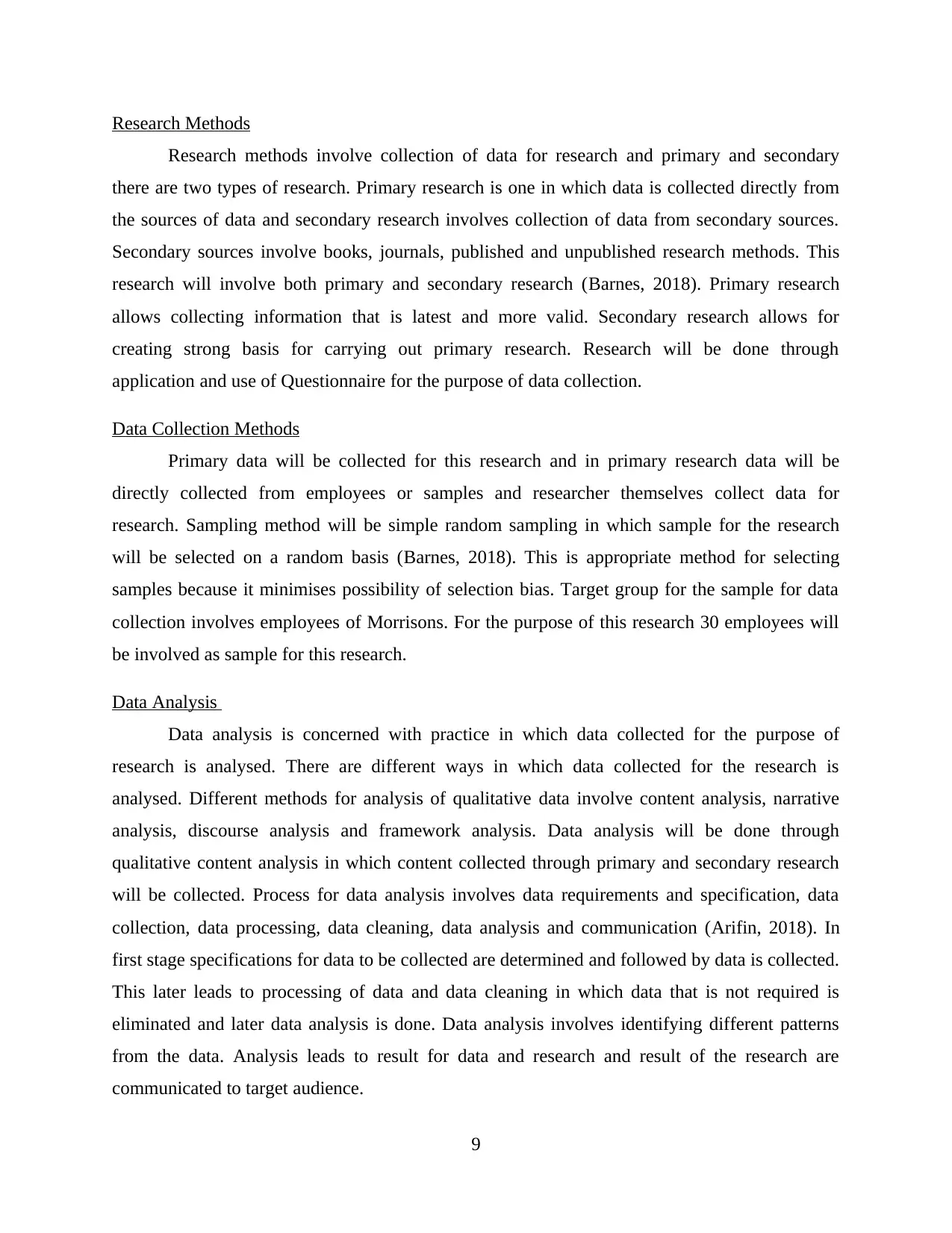
Research Methods
Research methods involve collection of data for research and primary and secondary
there are two types of research. Primary research is one in which data is collected directly from
the sources of data and secondary research involves collection of data from secondary sources.
Secondary sources involve books, journals, published and unpublished research methods. This
research will involve both primary and secondary research (Barnes, 2018). Primary research
allows collecting information that is latest and more valid. Secondary research allows for
creating strong basis for carrying out primary research. Research will be done through
application and use of Questionnaire for the purpose of data collection.
Data Collection Methods
Primary data will be collected for this research and in primary research data will be
directly collected from employees or samples and researcher themselves collect data for
research. Sampling method will be simple random sampling in which sample for the research
will be selected on a random basis (Barnes, 2018). This is appropriate method for selecting
samples because it minimises possibility of selection bias. Target group for the sample for data
collection involves employees of Morrisons. For the purpose of this research 30 employees will
be involved as sample for this research.
Data Analysis
Data analysis is concerned with practice in which data collected for the purpose of
research is analysed. There are different ways in which data collected for the research is
analysed. Different methods for analysis of qualitative data involve content analysis, narrative
analysis, discourse analysis and framework analysis. Data analysis will be done through
qualitative content analysis in which content collected through primary and secondary research
will be collected. Process for data analysis involves data requirements and specification, data
collection, data processing, data cleaning, data analysis and communication (Arifin, 2018). In
first stage specifications for data to be collected are determined and followed by data is collected.
This later leads to processing of data and data cleaning in which data that is not required is
eliminated and later data analysis is done. Data analysis involves identifying different patterns
from the data. Analysis leads to result for data and research and result of the research are
communicated to target audience.
9
Research methods involve collection of data for research and primary and secondary
there are two types of research. Primary research is one in which data is collected directly from
the sources of data and secondary research involves collection of data from secondary sources.
Secondary sources involve books, journals, published and unpublished research methods. This
research will involve both primary and secondary research (Barnes, 2018). Primary research
allows collecting information that is latest and more valid. Secondary research allows for
creating strong basis for carrying out primary research. Research will be done through
application and use of Questionnaire for the purpose of data collection.
Data Collection Methods
Primary data will be collected for this research and in primary research data will be
directly collected from employees or samples and researcher themselves collect data for
research. Sampling method will be simple random sampling in which sample for the research
will be selected on a random basis (Barnes, 2018). This is appropriate method for selecting
samples because it minimises possibility of selection bias. Target group for the sample for data
collection involves employees of Morrisons. For the purpose of this research 30 employees will
be involved as sample for this research.
Data Analysis
Data analysis is concerned with practice in which data collected for the purpose of
research is analysed. There are different ways in which data collected for the research is
analysed. Different methods for analysis of qualitative data involve content analysis, narrative
analysis, discourse analysis and framework analysis. Data analysis will be done through
qualitative content analysis in which content collected through primary and secondary research
will be collected. Process for data analysis involves data requirements and specification, data
collection, data processing, data cleaning, data analysis and communication (Arifin, 2018). In
first stage specifications for data to be collected are determined and followed by data is collected.
This later leads to processing of data and data cleaning in which data that is not required is
eliminated and later data analysis is done. Data analysis involves identifying different patterns
from the data. Analysis leads to result for data and research and result of the research are
communicated to target audience.
9
⊘ This is a preview!⊘
Do you want full access?
Subscribe today to unlock all pages.

Trusted by 1+ million students worldwide
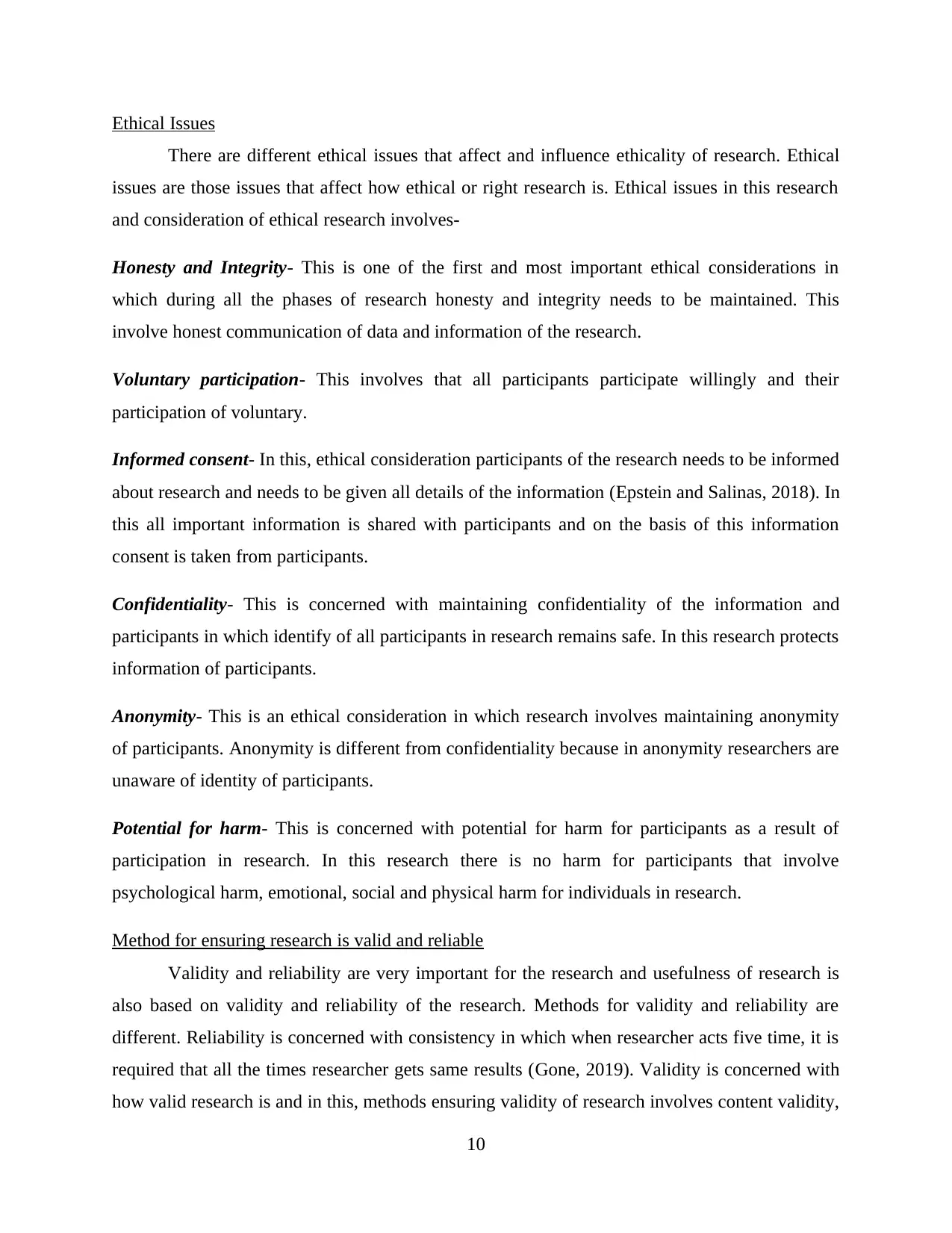
Ethical Issues
There are different ethical issues that affect and influence ethicality of research. Ethical
issues are those issues that affect how ethical or right research is. Ethical issues in this research
and consideration of ethical research involves-
Honesty and Integrity- This is one of the first and most important ethical considerations in
which during all the phases of research honesty and integrity needs to be maintained. This
involve honest communication of data and information of the research.
Voluntary participation- This involves that all participants participate willingly and their
participation of voluntary.
Informed consent- In this, ethical consideration participants of the research needs to be informed
about research and needs to be given all details of the information (Epstein and Salinas, 2018). In
this all important information is shared with participants and on the basis of this information
consent is taken from participants.
Confidentiality- This is concerned with maintaining confidentiality of the information and
participants in which identify of all participants in research remains safe. In this research protects
information of participants.
Anonymity- This is an ethical consideration in which research involves maintaining anonymity
of participants. Anonymity is different from confidentiality because in anonymity researchers are
unaware of identity of participants.
Potential for harm- This is concerned with potential for harm for participants as a result of
participation in research. In this research there is no harm for participants that involve
psychological harm, emotional, social and physical harm for individuals in research.
Method for ensuring research is valid and reliable
Validity and reliability are very important for the research and usefulness of research is
also based on validity and reliability of the research. Methods for validity and reliability are
different. Reliability is concerned with consistency in which when researcher acts five time, it is
required that all the times researcher gets same results (Gone, 2019). Validity is concerned with
how valid research is and in this, methods ensuring validity of research involves content validity,
10
There are different ethical issues that affect and influence ethicality of research. Ethical
issues are those issues that affect how ethical or right research is. Ethical issues in this research
and consideration of ethical research involves-
Honesty and Integrity- This is one of the first and most important ethical considerations in
which during all the phases of research honesty and integrity needs to be maintained. This
involve honest communication of data and information of the research.
Voluntary participation- This involves that all participants participate willingly and their
participation of voluntary.
Informed consent- In this, ethical consideration participants of the research needs to be informed
about research and needs to be given all details of the information (Epstein and Salinas, 2018). In
this all important information is shared with participants and on the basis of this information
consent is taken from participants.
Confidentiality- This is concerned with maintaining confidentiality of the information and
participants in which identify of all participants in research remains safe. In this research protects
information of participants.
Anonymity- This is an ethical consideration in which research involves maintaining anonymity
of participants. Anonymity is different from confidentiality because in anonymity researchers are
unaware of identity of participants.
Potential for harm- This is concerned with potential for harm for participants as a result of
participation in research. In this research there is no harm for participants that involve
psychological harm, emotional, social and physical harm for individuals in research.
Method for ensuring research is valid and reliable
Validity and reliability are very important for the research and usefulness of research is
also based on validity and reliability of the research. Methods for validity and reliability are
different. Reliability is concerned with consistency in which when researcher acts five time, it is
required that all the times researcher gets same results (Gone, 2019). Validity is concerned with
how valid research is and in this, methods ensuring validity of research involves content validity,
10
Paraphrase This Document
Need a fresh take? Get an instant paraphrase of this document with our AI Paraphraser
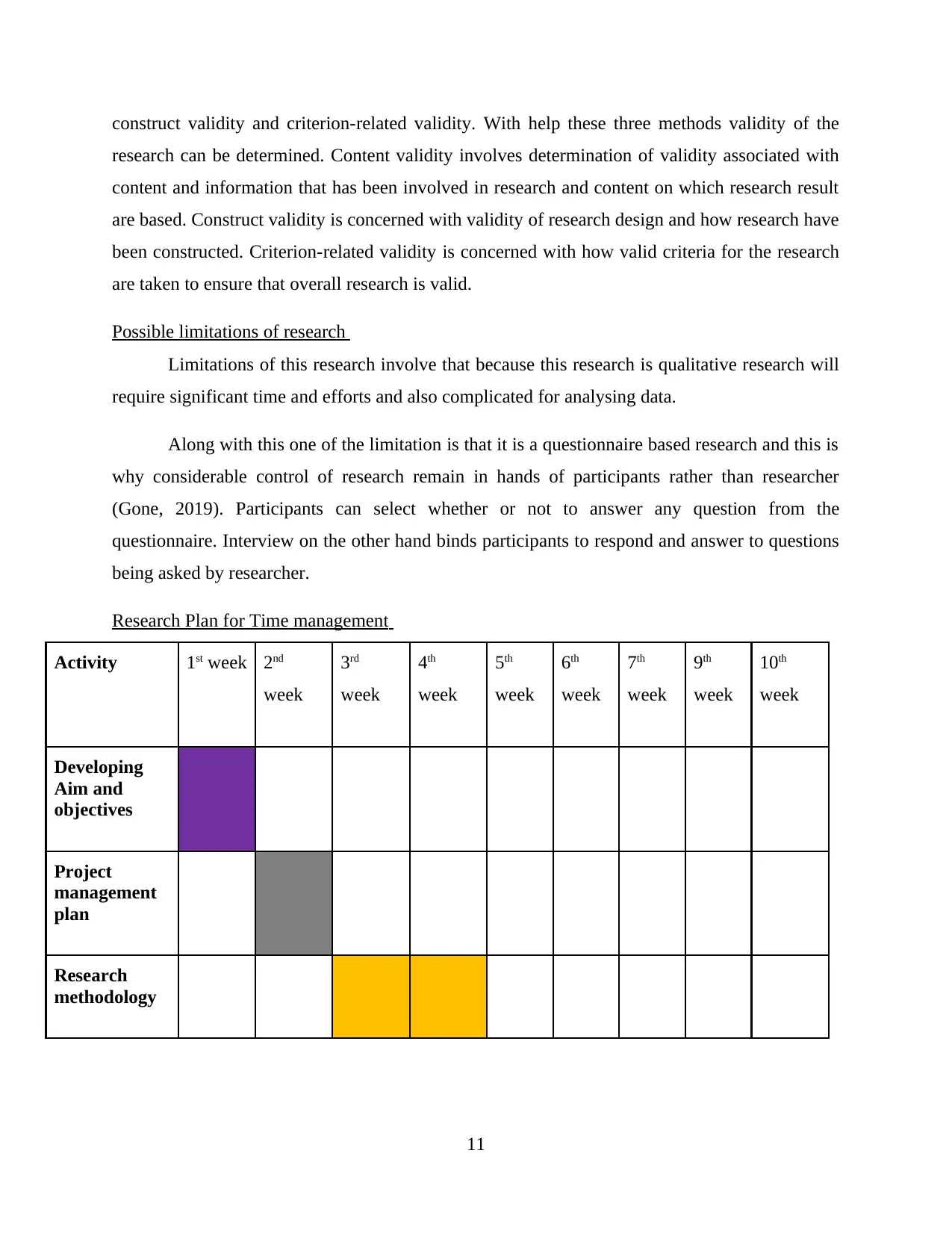
construct validity and criterion-related validity. With help these three methods validity of the
research can be determined. Content validity involves determination of validity associated with
content and information that has been involved in research and content on which research result
are based. Construct validity is concerned with validity of research design and how research have
been constructed. Criterion-related validity is concerned with how valid criteria for the research
are taken to ensure that overall research is valid.
Possible limitations of research
Limitations of this research involve that because this research is qualitative research will
require significant time and efforts and also complicated for analysing data.
Along with this one of the limitation is that it is a questionnaire based research and this is
why considerable control of research remain in hands of participants rather than researcher
(Gone, 2019). Participants can select whether or not to answer any question from the
questionnaire. Interview on the other hand binds participants to respond and answer to questions
being asked by researcher.
Research Plan for Time management
Activity 1st week 2nd
week
3rd
week
4th
week
5th
week
6th
week
7th
week
9th
week
10th
week
Developing
Aim and
objectives
Project
management
plan
Research
methodology
11
research can be determined. Content validity involves determination of validity associated with
content and information that has been involved in research and content on which research result
are based. Construct validity is concerned with validity of research design and how research have
been constructed. Criterion-related validity is concerned with how valid criteria for the research
are taken to ensure that overall research is valid.
Possible limitations of research
Limitations of this research involve that because this research is qualitative research will
require significant time and efforts and also complicated for analysing data.
Along with this one of the limitation is that it is a questionnaire based research and this is
why considerable control of research remain in hands of participants rather than researcher
(Gone, 2019). Participants can select whether or not to answer any question from the
questionnaire. Interview on the other hand binds participants to respond and answer to questions
being asked by researcher.
Research Plan for Time management
Activity 1st week 2nd
week
3rd
week
4th
week
5th
week
6th
week
7th
week
9th
week
10th
week
Developing
Aim and
objectives
Project
management
plan
Research
methodology
11
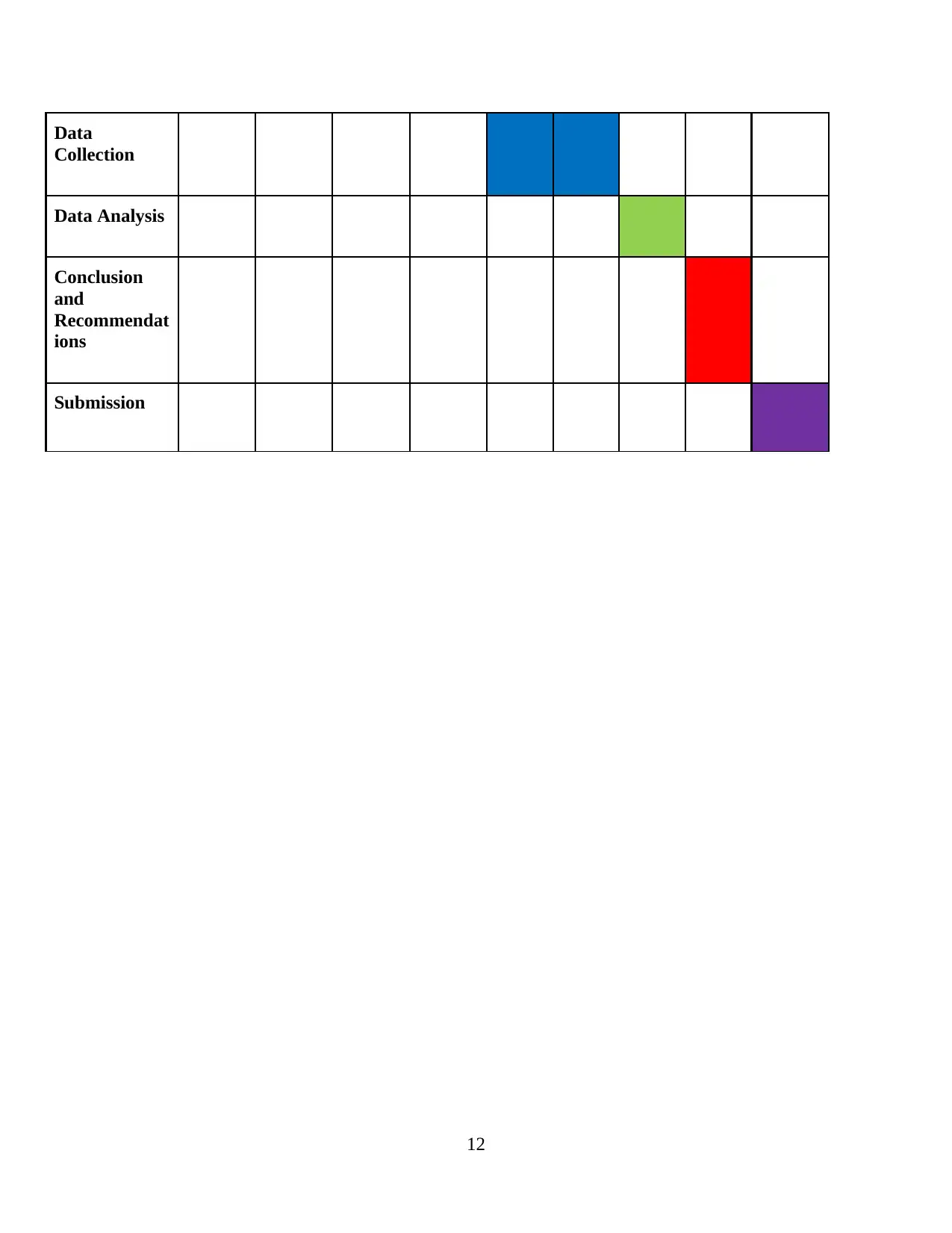
Data
Collection
Data Analysis
Conclusion
and
Recommendat
ions
Submission
12
Collection
Data Analysis
Conclusion
and
Recommendat
ions
Submission
12
⊘ This is a preview!⊘
Do you want full access?
Subscribe today to unlock all pages.

Trusted by 1+ million students worldwide
1 out of 14
Related Documents
Your All-in-One AI-Powered Toolkit for Academic Success.
+13062052269
info@desklib.com
Available 24*7 on WhatsApp / Email
![[object Object]](/_next/static/media/star-bottom.7253800d.svg)
Unlock your academic potential
Copyright © 2020–2025 A2Z Services. All Rights Reserved. Developed and managed by ZUCOL.





